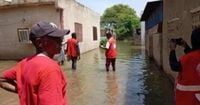Severe flooding has swept through Egypt’s northern Nile Delta this week, submerging farmland and homes in the fertile Beheira and Menoufia provinces and forcing evacuations in towns like Ashmoun. Egyptian officials have pointed the finger squarely at Ethiopia, blaming the recently inaugurated Grand Ethiopian Renaissance Dam (GERD) and what they call its "reckless unilateral management" for the dramatic spike in the Nile’s water levels. As the waters rose, videos circulated online showing residents wading through waist-deep floods, their homes—many built on vulnerable silt deposits—partially underwater and their livelihoods at risk.
The crisis has reignited a simmering diplomatic dispute that stretches back more than a decade, pitting Ethiopia’s ambitions for energy independence and economic development against the existential water security concerns of its downstream neighbors, Egypt and Sudan. The GERD, which officially began operations on September 9, 2025, stands as Africa’s largest hydroelectric dam, capable of producing over 5,000 megawatts and holding up to 74 billion cubic meters of water. For Ethiopia, the nearly $5 billion project is a symbol of national pride and a ticket to doubling its electricity generation capacity, meeting domestic demand, and exporting power to the region.
But for Egypt, which relies on the Nile for nearly all its freshwater, the GERD is viewed as a threat—one that could tip the delicate balance of water resources and, as seen this week, unleash new dangers. On Friday, October 3, Egypt’s Ministry of Water Resources and Irrigation issued a strongly worded statement, condemning what it termed "reckless unilateral actions by Ethiopia in managing its illegal dam, which violates international law." The ministry asserted that Ethiopia’s practices "pose a direct threat to the lives and security of the peoples of downstream countries."
Sudan, too, has felt the impact. Earlier in the same week, heavy flooding along the Nile in Khartoum forced about 100 families to evacuate their homes, as reported by the International Organization for Migration. Egyptian authorities allege that Ethiopia’s decision to open the GERD’s gates without coordination, combined with seasonal heavy rainfall, caused a sudden surge of water that inundated Sudanese villages and agricultural lands. The Sudanese Ministry of Water Resources and Agriculture, for its part, noted that climate change has delayed and intensified the seasonal rains, with both the White Nile and Atbara River experiencing unprecedented rises in recent years.
In response to the rising threat, Egypt was compelled to discharge large volumes of water from its High Aswan Dam—located more than 2,000 kilometers upstream from the Delta—through the end of October, a move intended to relieve pressure on the dam’s reservoir. Prime Minister Mostafa Madbouly, speaking at a weekly Cabinet meeting, warned that these releases could lead to flooding in low-lying areas of the Delta, particularly in Menoufia and Beheira. He urged residents squatting illegally on vulnerable lands to evacuate immediately, emphasizing that the government had issued clear warnings to local authorities to ensure these areas were cleared and damage minimized.
The government’s actions were not taken lightly. The High Dam, with its vast 162 billion cubic meter reservoir, has long served as Egypt’s primary water infrastructure, regulating irrigation and protecting the country from both droughts and floods. According to Water Resources and Irrigation spokesman Mohamed Ghanim, some of the excess water was directed to the Toshka spillway and its associated lakes and canals—a safety mechanism first activated in 1996 when water levels previously soared. The Ministry of Water Resources and Irrigation reassured citizens that the High Dam remains "the primary safeguard" against fluctuations in the Nile’s water levels, even as the current crisis unfolds.
Ethiopia, meanwhile, has rejected Egypt’s accusations as "unfounded and misleading." Water Minister Habtamu Itefa Geleta claimed earlier in the week that the GERD had actually helped mitigate what could have been even more catastrophic flooding in Sudan. "The flood in Sudan could be from the White Nile. If GERD was not there, the magnitude could have been devastating. GERD played a significant role in reducing the catastrophic effect," he said. Ethiopian officials have consistently maintained that the dam is vital for their country’s development and that their management of the Nile’s waters is both equitable and reasonable.
Yet Egypt and Sudan remain unconvinced. Both countries argue that Ethiopia’s operation of the GERD violates colonial-era agreements on Nile water sharing and the 2015 Declaration of Principles, which states that the interests of downstream nations should not be adversely affected by the dam’s construction or operation. Egypt, in particular, has repeatedly called for a legally binding agreement governing the dam’s management—a demand Ethiopia has thus far resisted, proceeding instead with annual reservoir fillings and water releases without consultation.
The diplomatic temperature has only risen in the wake of the flooding. Egyptian Foreign Minister Badr Abdelatty underscored the high stakes, declaring that Egypt "fully retains its right... to defend its existential interests and water rights by all means and tools." The government has activated emergency protocols and is closely monitoring developments, with Prime Minister Madbouly warning that water levels are expected to remain high through October, continuing to threaten northern governorates.
Behind the scenes, Egypt has been preparing for such scenarios for years. Minister of Water Resources and Irrigation Hani Sweilam noted in a recent interview that Egypt has taken steps to preserve its water resources and prepare for droughts, including the National Project for the Rehabilitation and Lining of Canals and Waterways. This initiative, which has already lined over 7,000 kilometers of canals, aims to save approximately 5 billion cubic meters of water annually and improve water quality and agricultural productivity. Egypt has also embarked on a National Desalination Strategy, with the goal of producing 10 million cubic meters of desalinated water per day within the next five to six years—a vital step, given that the country’s annual water needs far exceed its available resources.
For many Egyptians, the Nile is more than a river—it is the lifeblood of the nation, essential for drinking, farming, and industry. The current crisis has laid bare just how precarious that lifeline can be, especially as upstream developments and climate change introduce new uncertainties. As diplomatic efforts continue—often with international mediators like the United States seeking a neutral stance—the dispute over the GERD remains unresolved, with all sides insisting on their rights and security.
Whether a lasting agreement can be reached remains to be seen. For now, the floodwaters in Egypt’s Delta are a stark reminder of the interconnectedness—and the fragility—of the Nile Basin’s future.





